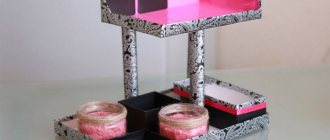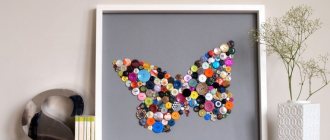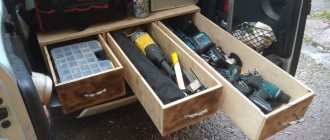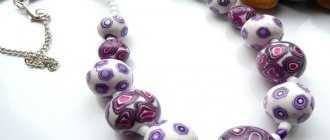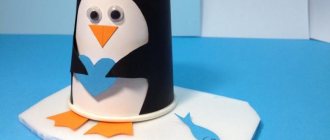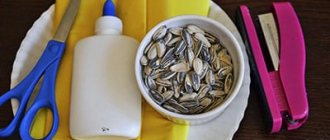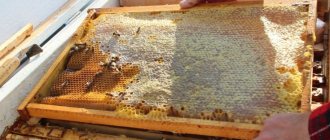The more often a woman sews, the more different sewing accessories appear in the house. A pressing problem for many needlewomen is how to store threads so that they do not get tangled. Disorder in this matter is unacceptable. The threads can fluff up and get tied into knots every now and then. Not to mention that the coils piled up are inconvenient to work with. The wisest solution in such a situation is to use a storage organizer. You can buy it or make it yourself. We will focus on the second option.
Bobbins
It’s very simple, but I still don’t know where to find such a ring. Can be replaced with a carbine
The transparent box allows you to see the entire arsenal of bobbins
I recently bought a box like this through Aliexpress. The set also included 25 different colored bobbins. They fit my Janome machine perfectly, I don’t see any difference with the original branded ones. The reviews say that the owners of the Brother machine were also satisfied with the purchase.
Of course, I wrote that the minimum sewing kit should include 3-5 bobbins. But I wind a full bobbin of every thread I have - to save time.
To prevent the threads from the bobbins from getting tangled, put small elastic bands on them.
Did you also notice that these are ice molds?
Each bobbin will have its own place in the medicine boxes
I really liked this idea: especially when you have 50 shades of white thread in your arsenal. But it seems that then the skeins will take up too much space.
Convenient do-it-yourself bobbin holder stand
Today I decided to show you how you can quickly and inexpensively make your own bobbin holder for your household sewing machine.
This is probably a relic of my production activity, when while working at a sewing enterprise of a chain of consumer service ateliers, I got used to using large spools of 2500 and 5000m sewing thread on my home machine, especially since they used to be very inexpensive.
Previously, my old table had a large 5-position bobbin holder for industrial sewing machines bolted to it. It simultaneously contained threads for an industrial overlocker 51-A class PMZ, converted into a household one and installed on the same table to the right of the sewing machine, and threads for my trouble-free workhorse Brother XR-36. No matter how accustomed I am to it, after 16 years of merciless use, 5 years ago I finally decided to replace it with Brother INNOV-'IS 350SE.
The machine was changed, a knitted overlocker and a topstitcher were purchased, and the work place also changed.
I was left without a convenient rack for large reels. On the Internet I looked for a household rack that has a stable base and is simply placed on the table, and is not screwed to it, like an industrial one. But I’ve never seen one like this in sewing equipment stores.
Reel storage
Spools of thread should be stored so that thin threads do not unravel or become tangled. If sewing is your favorite hobby, then you undoubtedly have a lot of such material. In this case, you can use the drawers of your bedside table or chest of drawers, which are equipped with special inserts with pins on which the coils are placed.
The palette of threads for machine embroidery, for example, can have a fairly large number of shades of the same color. In this case, transparent plastic buckets will help you store the coils, in which you can put the coils according to a certain color.
Seven daily habits of happy people
The star of the series “Sultan of My Heart” spoke about the choice of his future wife
25 children of a childless man: an extraordinary reunion
You can sew a convenient and practical organizer for spools with your own hands - add a piece of thick fabric with loops made of regular underwear elastic, under which the spools will be tucked.
You can also set a goal in a craft store to find a convenient option for storing spools of thread. For example, in the form of a transparent rotating barrel on a stand.
Hooks
The principle of choosing a hook is practically no different from choosing knitting needles. Just like knitting needles, hooks come in different thicknesses and can be made from completely different materials. They must also be selected according to the thickness of the thread used in the work. The most popular hooks are not too long - only about 15 centimeters. They are used when performing various techniques and when working in many techniques.
Some elements, such as the “postal column,” are more convenient to perform on a special hook with a foot. Instead, you can use a hook from a knitting machine of suitable thickness.
How to store sewing thread
The most convenient and beautiful ways to store sewing threads are in our selection!
Last time we discussed various ways to store fabrics for sewing, and today we’ll talk about another “headache” for thousands of needlewomen. Endless coils are trying to scatter throughout the house, if you just get distracted for a second! If you are still looking for the perfect way to store sewing threads, you will surely find it in our selection.
How to Store Sewing and Craft Fabrics
In transparent jars, the coils look impressive, although one cannot help but admit that a note of chaos still remains in this storage option.
By the way, for many needlewomen this method has become the starting point for decorating... lamps!
Storing yarn and floss
Embroiderers and knitters treat even small pieces of yarn or floss with care. And such leftovers need to be stored wisely so that the threads do not get tangled and they can be easily found. One of the simple ways to save leftover threads is to wind them on a regular clothespin - the ends of the thread will be clamped in the jaws of the clothespin, they will not unravel, and the necessary remnant can be found immediately.
A broken nail is no problem: tips for treating nails at home
When toothpaste is harmful to children: permissible age doses
From athletes to Hollywood stars: men Naomi Campbell
You can also use transparent jars with screw caps to store small balls. The jars can be equipped with magnets and hung from the underside of the shelf above the desktop, where a magnetic or metal strip has been previously secured.
If you have a special place in the room for work, then on one of its walls you can make a panel organizer where skeins of yarn will be placed.
Multi-color knitting is difficult because the balls get tangled, the threads intertwine, and you have to unravel them all the time. You can make this knitting process easier by using ordinary containers in which you can make holes for threads. The balls need to be lowered into the container, pulling the tail through the hole, close the container with a lid - and you can safely knit.
Balls, skeins or skeins can be stored in an organizer with transparent pockets - this way they will be clearly visible, and the organizer itself, hung on the wall, will not get in the way.
I hope that you will use at least one of the proposed options for storing needlework threads, which will undoubtedly help you in your creativity.
Knitting process
This device is suitable for knitting socks and mitts. To secure the loop, you must move clockwise. The tail of the thread is held in the left hand, and a turn is made on the button with the right hand. Having made a full move, perform another row. And in the third row, the previous loops (loops of the first row) are thrown over the loops of the second row. To do this, use a hook or hand to lift the loop of the bottom row, slightly pull it up and drop it from the paperclip. Row after row of yarn knitted together lengthens. Knitting using this technique is loose but elastic. Due to this, you don’t have to knit the heel on the toes - the fabric will sit comfortably on your leg.
Knit this way until the sock or mitt reaches the required length (to the big toe or heel). To decrease the loops, they make gaps in knitting - they throw the yarn not on each axis, but through one.
Anyone can make an unusual but useful knitting device for themselves. The main thing is to understand what is needed - convenience, functionality, increased speed. A device for knitting mitts, socks, and scarves can be designed to suit the needs of the craftsman.
Source
Wall organizer
Those who sew professionally and have dozens of skeins available can make a wall organizer for spools of thread with their own hands. To do this you will need a sheet of plywood, a hammer, long nails, a baguette for decorating the frame, and paint.
The size depends on the number of threads. Cut a rectangle out of plywood, make markings on it, drawing a grid with cells whose size is slightly larger than the diameter of the coil. Using an awl or nail, make notches at the intersections of the lines, where the nails will subsequently be driven in. Make a frame from foam ceiling fillets or a baguette and insert a plywood blank into it.
Paint or decorate in any other way. You can decoupage or burn a picture. After this, drive in the nails. For best results, they should be positioned slightly at an angle to the base. In this case, the coils will not slip off and will be clearly visible.
At the back you need to attach a hook for hanging or other fastening system.
Specific devices
Experts offer this type of device as a ceramic knitting bowl. Similar knitting devices are made by craftsmen who work with clay. However, a similar design can be made from a plastic shampoo container or bottle. To do this, 2/3 of the neck of the container is cut off. The remaining part is placed on its side and the slot line is marked with a marker. It should be a twisted line that curves downwards. Due to the shape of the coil, a thread falling into it will not try to escape, but will get inside and will not slip off.
It is better to treat the edges of such a device - paste it with tape or colored adhesive paper. If you have a heat gun, then a layer of glue applied in two or three approaches will perfectly cover sharp cuts. The slot should not be too shallow. As a rule, 0.5-0.7 mm is enough for even thick yarn to fit perfectly in the container.
Ideas for choosing storage space
Today you can find many interesting and convenient devices on sale that allow you to store threads and other tools. It is also quite possible to make them yourself.
Jar
In transparent containers, colored coils look very interesting. However, certain notes of chaos still remain when choosing this method.
Organizer box
Thread in spools or skeins for knitting are often stored in shoe boxes. To do this, you should use cloves. Regular toothpicks will also work.
Cookie box
Almost everyone can find a round tin of cookies in their household. Many people prefer to keep hooks, buttons, and beads in such containers. It can be used to make a comfortable thread organizer.
Hanging organizer
Stores sell many affordable organizers that are designed for closets or garages. They are made from plastic or textiles. Typically, such devices are used to store shoes. You can keep useful little things or tools in them. Organizer pockets can be used for threads.
Lockers
Not every needlewoman can buy an expensive organizer cabinet for storing sewing threads. However, it is perfectly acceptable to add internal compartments to existing cabinets. However, it is not at all necessary to use wood for this. Such partitions are made of cardboard.
Doors
Cabinet doors should be used as a convenient device for storing sewing supplies. However, this will require woodworking. To do this, it is worth measuring the door and determining the location of the slats. It is recommended to be extremely careful, since the cabinet must close well. The position of the holes can be easily marked on the slats.
Wall organizer
This is one of the most time-consuming options. At the same time, it needs enough space on the wall. The advantage of such an organizer is its spectacular appearance and amazing convenience.
Dummy
This device is often used by needlewomen. It can be adapted for threads. You can also hang a measuring tape, scissors, pins and other equipment required for sewing on the mannequin.
Magnetic boxes
Magnetic boxes are used for metal fixtures. To do this, it is recommended to glue a small magnet to a suitable container. This is done with ordinary superglue. The advantage of such a device is the ability to store various pins and needles that will not fly around the room.
Disc boxes
Such organizers are suitable for storing threads and needles. To do this, remove the cover and place the cases with needles inside. As a result, you will be able to get a comfortable transparent organizer. The advantage of such packaging is that all the devices are in plain sight. It is recommended to put information on the contents of the container on top. CD cases take up little space.
They are worth putting on a bookshelf. Thanks to this, you can quickly find the necessary tools. It is permissible to put inside not only needles, but also ribbons, buttons, and hooks. Separately, it is recommended to make containers for threads.
Using Surfaces
It is permissible to store threads in different pieces of furniture. Tables, cabinets and even doors are suitable for this.
Table
It is recommended to fix various organizers under the sewing table that can be used to store threads. These include plastic containers or textile pockets. This will allow you to keep everything you need at hand.
Interior doors
To store threads, you should use special organizers that are hung from the interior door. You can place everything you need in them. The extra surface helps save space.
Rotating organizer
It is recommended to make an organizer from a round tin cookie box. It is very easy to make. Thanks to this, the coils can be placed in a visible place.
Pocket hoops
To make original pockets, you should stretch them onto an ordinary embroidery hoop. In addition to threads, it is recommended to place pencils and scissors in the resulting pockets. They also contain other tools. Such pockets will harmoniously fit into the interior.
Case for scissors
Craftswomen who like to use pockets for various sewing items will be able to make successful scissor covers. For this you will need cardboard, textiles, and glue. For decoration, it is permissible to use ribbon and lace.
Boxes are often used for sewing accessories. In addition to threads, you can hold needles and other sewing items in them.
Organization and storage of embroidery needles
It is important for needlewomen to organize and store needles - these irreplaceable helpers. As you know, embroidery needles come with both blunt and sharp tips.
A variety of needle beds are perfect for storing them, including improvised ones, as in the photo below:
And also branded and homemade, magnetic or just magnets.
Magnetic pincushion and magnet
Handmade needle beds
Each needlewoman should have several needle cases: for general storage and separately for embroidery processes.
MASTER CLASSES ON CREATING NEEDLE CASES WITH YOUR OWN HANDS
A variety of crooked pincushions are also great as handmade pincushions.
It is worth special mentioning the branded magnetic needle beds-tubes, which are especially indispensable for the embroidery process on the road.
Some needlewomen make similar needle cases in empty lipstick cases.
Pincushion tubes with magnet and rotating body from Prym
And here's an example of how you can organize and store spare needles.
A small organizer-container was used as a basis, the needles were sorted by size and labeled, stuck into cells with material from the packaging of computer components. Needles are also stored here in branded packaging.
How to care for needles
There are many ways and possibilities to keep needles suitable for work for a long time.
Devices for sharpening and polishing needles and special needle beds will help you cope with cleaning needles.
The tomato is a pincushion filled with soft material, and the berry is intended for cleaning and polishing the needles and is filled with the appropriate filler.
“Pomodoro” and “medallion” for polishing and cleaning needles
The well-known GOI paste (invented at the State Optical Institute, where it got its name) will also serve you as a good grinder and needle polisher.
A piece of GOI paste
Some needlewomen recommend using more inexpensive household items, such as old polishing nail files, to clean needles. Or regular dishwashing sponges (use the hard side of the sponge).
By organizing your floss threads and embroidery needles in one or more of the ways listed above, or in any other option convenient for you, you will not only put things in order in your needlework corner, but you can also easily maintain it in an attractive, neat aesthetic appearance and - most importantly - you will save your time more than once when searching for the right materials for your embroidery processes
The author of the article and photographs is Tatyana Pozhidaeva (Podsolnushek)
Bobbins for floss
Small but necessary helpers in organizing and storing floss are bobbins. It is on them that you need to rewind the threads for storage in container organizers.
Cardboard bobbins are significantly inferior in quality and durability to plastic ones, so they are best used for infrequent use, or as a one-time use for one separate embroidery process, or for storing leftover threads on them.
One bobbin is intended for one standard (8 m) skein of floss. A bobbin with thread from two skeins will take up more space in the organizer and is not so convenient to use: when pulling it out of the box or, conversely, placing it in a container, the “extra” threads cling to adjacent bobbins and slide off.
Plastic bobbins with thread from two skeins (8 m DMS floss and 20 m PNK floss)
From the video from Lelya Lee you will learn how to make exclusive bobbins in the form of pinkies with your own hands.
Oksana Dereza in her video gives a detailed comparison and review of organizers-containers and bobbins for floss from different manufacturers, indicating their advantages and disadvantages.
Device for winding floss onto bobbins
A bobbin thread winder is a great addition to your craft accessories. Using this device, threads are wound onto bobbins easily, quickly and accurately. These special devices are produced by different manufacturers and are relatively inexpensive, and their help is quite significant, including in the form of significant savings in precious time spent on rewinding threads from a skein.
Device for rewinding floss onto bobbins
The floss rewinder is easy to use, but let’s take a closer look at some of its operating points.
It is most convenient to mount the device on the side wall of a free cell of a container for storing floss.
The gap between the wall of the box and the device is somewhat large, so for the stability of the winder it is necessary to fill the space, for example, with a piece of cardboard, paper folded in several layers, or by placing three cardboard bobbins for floss there.
Having prepared the winder in this way, we insert a bobbin into a special hole, having previously pasted on it or signed by hand the number of the thread that we will wind, secure the bobbin with a pin, fasten the beginning of the thread in special slots on the bobbin and with pleasure, easily and quickly, rewind the threads from the skein onto the bobbin, we also fasten the end of the thread into the slot.
It happens that when winding quickly, the pin falls out of the hole, so it is recommended to initially insert it all the way and press it harder with your finger, as if securing it in place.
When winding floss onto a bobbin, it is more convenient if the skein of thread hangs from the table, unwinding under its own weight, guide the thread by hand and, if necessary, straighten the paste.
We do not pull the thread onto the bobbin tightly to avoid strong creases, although during the embroidery process with threads stored wound on bobbins, all creases on the floss are smoothed out.
If you want to show your imagination and immerse yourself in creativity, you can make a similar universal device with your own hands and an interesting video from Dunyasha Cross-stitch will help you with this.
https://youtube.com/watch?v=-4nTjZb1fVg
Stickers with thread numbers
Indicating the floss number is fundamentally important for proper storage and use. Everything here is extremely simple: some people prefer to use special branded stickers, others sign by hand, while others find it more convenient to use numbers from the skein labels cut out and glued to the reels.
One working moment on branded stickers. VHI in sets with such stickers, in addition to the square stickers with the indicated floss numbers, has blank sticker squares.
Stickers with numbers and blank squares
What are the blank sticker squares used for? You can write the numbers you need on them yourself!
DIY skein holder. Now with bearings
Good day everyone! In 2022, I already showed how to make a skein holder with your own hands using a spinner, here: https://www.stranamam.ru/post/14185437/
And today I want to tell you how I improved the holder, since the lid of the spinner did not withstand long (well, 2 years already) use, as well as several falls with the help of my younger children. At first I tried to repair the lid: I glued it with hot glue. The last time was sealant. But I’m already tired of fixing it, to be honest. You need a normal bearing with a shaft, or an axle, with anything, as long as it works.
I came to the store, which is called “Bearing”, and turned to a consultant. After scratching my head at first, he offered me a wonderful option: these are 2 bearings of different sizes, one fits into the other. You can either secure it with self-tapping screws along the edges using a screwdriver, or drill out a niche of the appropriate size with a feather drill and insert a bearing there, or my option is to go along the outer edge with hot glue. Which is exactly what I did. I will show you now:
these are spinner caps that have been torn off many times, 4 new bearings (the outer diameter is 5cm and 3cm, the larger one has an inner diameter of 3cm), my husband removed the spinners with a knife, I cleaned the central places with coarse sandpaper, the outer edges of the bearings I carefully wiped off the oil with a glass cleaner so that the glue would stick
This is how the bearings will work: one will fit into the other. I center the attachment points and outline them with a pencil:
my friend is a glue gun
I glued only along the outer edge, everything around the bearing was already glued, traces of glue from the spinner were cooling on the plexiglass circle - I couldn’t clean it completely
I screwed in the axles, now I combine the top and bottom
Source
Lockers
Not everyone has the opportunity to purchase expensive sewing thread organizer cabinets, but adding compartments inside the cabinets you already have is actually not that difficult. Moreover, it is absolutely not necessary to use wood; partitions can also be made from cardboard.
Cabinet doors can easily be turned into a convenient organizer, but for this you will have to work with wood.
Measure your door and determine the position of the slats: be extremely careful as your door needs to close tightly. Mark the position of the holes on the slats.
Drill holes using a drill and drive in pegs.
Paint it the color you want and glue it to the doors.
Tips for an embroiderer
All the options described above concerned bobbin threads. But embroiderers use floss, which is sold in skeins. If they are stored haphazardly, they get mixed up, which complicates the work. There are several ways to make a floss thread organizer with your own hands.
Plastic bobbins are one of the common options. You can buy them or make them yourself by cutting out blanks from plastic. Used shampoo bottles, thick packaging plastic or bottles can be used. Use scissors or a soldering iron to cut out the shape of the workpiece. This could be a 6 x 8 rectangle with rounded edges.
You can make it in the form of a “bone” or choose any other shape. It is necessary to make notches into which the ends of the threads will be inserted, this will prevent unwinding. Floss is wound onto such bobbins, and a label with the manufacturer's number or brand is pasted for organization.
Such reels can be made from thick cardboard, but they will not be as durable as plastic.
Another option is a thread holder. It is a strip with rows of holes cut along the edge. A different color is inserted into each hole. Such holders are convenient for work, so you don’t have to look for the right shades - they are always at hand.
You can make them from thick cardboard by cutting out a rectangle measuring 15 x 10 cm. You need to make holes along the long edge using a hole punch, retreating 1.5 cm. A skein of floss must be straightened along the length, folded in half and inserted into the hole with the fold. You need to thread the ends into the resulting loop and tighten it, you get a “fringe” of floss. You can write the color number above the holes with a pen or felt-tip pen.
In order for the cardboard to last until the end of the work, it is recommended to laminate it with tape on both sides. And after that insert the threads.
Making a stand for large bobbins for a household sewing machine
Many beginning seamstresses are faced with a situation where they have a large spool of thread (also called industrial thread) of the desired color, but they are using a household sewing machine, where it is quite difficult to place this spool.
Of course, there are options. One of them is to rewind the thread from a large bobbin onto a regular spool and sew as usual. But time is lost on rewinding; the winding is very far from the factory one.
I propose to solve this problem by making a stand for large reels. It will take a couple of hours to make. But how much working time can it save?
To make the stand we will need:
- materials:
- Base material. Plywood with a thickness of 16 mm is suitable.
- Fastening accessories: bolts, nuts M5; M4 nuts; M6 nuts.
- Hook-bolt M4*50 mm - 2 pieces
- Aluminum square profile 10*10 mm.
- Aluminum tube with a diameter of 8 mm.
- Aluminum rod with a diameter of 6 mm.
- tool:
- Wood saw.
- Metal hacksaw (or cutting machine).
- M6 thread cutting tool with holder (although you can do without it).
- Hammer.
- Grinding machine or block with sandpaper.
- Marking tool (square, pencil or scriber).
- Drill with drills with diameters of 4 mm, 5 mm, 6 mm, 8 mm.
- patience
First of all, mark and cut the workpiece:
in the following sizes:
Three blue dots are drilling locations. 2 points located on the same axis are the centers of the reels. One offset point is the base of the post.
We drill holes. We drill the center of the bobbins with a 6 mm drill, and the base of the stand with a 5 mm drill.
Sand the workpiece and set it aside.
To make a rack, we need aluminum parts that are sold in hardware stores: a square, a tube and a rod.
Let's make a stand from a square section profile:
To do this, we will cut a piece of the height we need (you must first measure the height of your sewing machine and make it a little higher). In my case it turned out to be 36 cm.
On one side of the rack we drill a hole with a diameter of 8 mm for a horizontal guide.
on the other side we hammer in the M5 bolt so that the threaded part partially sticks out.
We screw the stand into place and make a horizontal jumper from a tube with a diameter of 8 mm and a length of 18 cm.
We make holes in the tube with a diameter of 4 mm and screw the hooks into them. We make holes at a distance of 3.5 cm from the edges and on the same axis.
We cut racks for the coils from a rod with a diameter of 6 mm.
There can be many mounting options. I cut the threads and screwed them into the base.
Putting everything together, we get this stand for 2 reels.
To prevent the stand from moving on the table, you can stick rubber feet or felt stickers to the bottom.
Once everything was assembled, I had to drill another 4mm hole in the top of the B-pillar in order to secure the horizontal crossbar. In the photo above you can see the black bolt that holds the horizontal jumper from twisting.
Source
Organizers for storing floss
Container for household items with supplies for needlework
The same container with floss
Advantages of storing floss in a container
- In organizer-containers, floss threads are stored compactly, do not become disheveled and do not gather dust.
- All thread numbers and colors are visible.
- Bobbins with threads wound on them can be arranged in any order convenient for you.
- Containers from DMS have an insert for keeping track of the threads in them. However, it is worth noting that needlewomen, as a rule, do not have enough time to use it constantly)
Sheet for recording floss in a container
Some needlewomen store data on the presence of threads on the computer, creating for this purpose files with special tables with a list of thread numbers they have by company.
How to arrange threads in a container
You can store threads in any order convenient for you, both in store-bought boxes and in home-made boxes and organizers.
By numbers or colors
Store threads separately by floss manufacturer, organizing them by number or color.
Until recently, Kirov floss was produced without numbers, so it makes more sense to store them by color
PNK threads in a container for household items
The bobbins fit the height of the cells and do not press or bend under the lid.
Closed container
Organizer with floss packed in ascending numbers
By thread composition
You can sort the floss according to the composition of the threads (cotton, metallized, silk, melange, etc.)
Organizer with silk and metallic threads
Threads for one large process
Larger containers can store materials for each individual large embroidery process or several smaller processes.
It is convenient to use an organizer box for the current process, placing in it not only the necessary floss, but also other necessary things: in one of the cells we put an improvised needle bed with additional needles and a thread take-up, in the other - scissors, colored pencils or markers for marks on the diagram, a magnet for quickly finding a suddenly lost needle and anything else you think is necessary.
Container organizer and special organizer from Pako for working needles with materials for one large process
And here is an organizer-container with materials for several small processes.
Please note: the thread columns for each individual process are signed!
Threads for a small process
Materials for each small process can also be stored in a separate, small container or in a homemade organizer box. This is also true for embroidery that you take with you on the road.
If all your organizers are labeled, you will be able to find the necessary strings very quickly. On the container boxes themselves, we do this using stickers on three sides (except for the back - with the lid attached): no matter which side you put the box for storage, you will always see the inscription with its contents.
Containers with the numbers of incoming threads indicated on stickers
Organizers are also stored compactly, conveniently and neatly on a shelf in a closet, chest of drawers or drawers.
